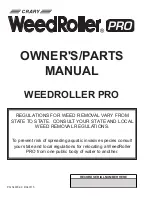
Assembling the Sample Cylinder and Valve
We recommend using a new valve with your new cylinder. If a valve has been used
previously, the threads might be damaged and possibly will not make a proper seal.
1. Clean the threads on the valve and cylinder, then examine the threads for dam-
age such as burrs, dents, nicks, or gouges. Reject or repair a valve or cylinder with
threads showing these defects.
2. Apply 3 wraps of PTFE tape (e.g., ResTape, cat.#22486) to the valve threads, leaving
the first (lead) thread exposed.
3. Install the valve onto the cylinder by inserting and hand tightening to engage
at least 2 but no more than 3 threads. If the valve fails to start easily, examine to
confirm the valve is to gauge. Also, recheck the valve and cylinder for damaged
threads.
4. Secure the valve and cylinder assembly in a holding device, using protective mate-
rial around the cylinder to prevent gouging of the sidewall. Using a torque wrench,
tighten the valve to 8 to 10 foot-pounds, maximum. This torque should produce
another 2 to 3 threads engagement, for a total engagement of 4 to 6 threads.
Cleaning
To clean a treated part, rinse with a solvent that will dissolve probable surface contami-
nants (i.e., use a nonpolar solvent to remove hydrocarbon contaminants, or a more
polar solvent to remove more active contaminants). Avoid using cleaners containing
abrasives as they can scratch the surface layer. Mild sonication might assist in remov-
ing contaminants, but do not oversonicate—this could damage the surface layer.
Do not use basic solutions with pH>8.
Do not steam clean
any Restek treated system components or line, as this could
damage the surface layer.
Treatment Layer Appearance
The appearance of a Restek treated surface can vary from lot to lot. Small variations in
surface thickness (measured in angstroms) affect layer appearance. The surface finish
should be bright and free of defects, but original surface condition can have a major
impact on final surface quality.
Your parts are cleaned after treatment; however, the surface may contain some trace
silicon (black particles) as a byproduct of the treatment process. Residual silicon can
be removed by rinsing with a solvent or by sonication in water (do not oversonicate).
Galling
As with any threaded fitting, galling may occur when assembling two treated thread-
ed parts. To prevent thread damage, use a thread lubricant or PTFE tape (e.g. ResTape
Stainless Steel Thread Sealing PTFE tape, cat.# 22487). Galling potentially can be
reduced when assembling a treated part and an untreated part.
(Sulfinert® Treated)
High Pressure Sample Cylinders
• Sulfinert® coating provides stable storage of sulfur and mercury at ppb levels in petro-
leum samples.
• Inert coating doesn’t flake; more durable than PTFE.
• TPED compliant cylinders now available for shipping into EU countries.
• All cylinders have
1
/
4
” female NPT threads on both ends.
Refinery and natural gas samples often contain trace amounts of sulfur-containing
compounds which can interfere with reactions or poison catalysts in petrochemical
processes. Because sulfur compounds quickly react with stainless steel surfaces, accu-
rate determination of these compounds is impossible when samples are collected and
stored in untreated sample cylinders. The Sulfinert® passivation technique bonds an
inert silica layer into the surface of stainless steel, preventing active compounds from
reacting with or adsorbing to the
steel. These Swagelok® high pres-
sure sample cylinders are Sulfinert®
treated for greater stability of sulfur
compounds and mercury. DOT rat-
ing to 1,800 and 5,000 psig allows
sampling at gas wellheads as well
as in the refinery. Use of high pres-
sure sample cylinders is cited in
ASTM D1265, Standard Practice for
Sampling Liquefied Petroleum (LP)
Gases, Manual Method.
Sulfur compounds are stable in Sulfinert®
treated stainless steel systems.
17 ppbv hydrogen sulfide in 500 mL cylinders
Relative
response:
hydrogen
sulfide:dimethyl
sulfide
also
available
Certificates are available upon request.
304L Stainless Steel
1,800 psig
TPED, 1,450 psig
Size
qty.
Swagelok part #
cat.#
price
Swagelok part #
cat.#
price
75cc
ea.
304L-HDF4-75
24130
150cc
ea.
304L-HDF4-150
24131
304L-HDF4-150-PD
24131-PI
300cc
ea.
304L-HDF4-300
24132
304L-HDF4-300-PD
24132-PI
500cc
ea.
304L-HDF4-500
24133
304L-HDF4-500-PD
24133-PI
1000cc
ea.
304L-HDF4-1000
24134
304L-HDF4-1000-PD
24134-PI
2250cc
ea.
304L-HDF4-2250
21394
304L-HDF4-2250-PD
21394-PI
316L Stainless Steel
5,000 psig
TPED, 4,350 psig
Size
qty.
Swagelok part #
cat.#
price
Swagelok part #
cat.#
price
150cc
ea.
316L-50DF4-150
22111
316L-50DF4-150-PD
22111-PI
300cc
ea.
316L-50DF4-300
22112
316L-50DF4-300-PD
22112-PI
500cc
ea.
316L-50DF4-500
22113
316L-50DF4-500-PD
22113-PI
304L-HDF4-75-PD
24130-PI






















